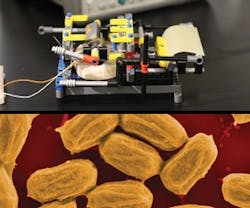New Generator Powered by Bacteria and Humidity
A new prototype generator harnesses the power of evaporating water, paving the way for commercial generators driven by changes in humidity from ponds and harbors.
Developers from Harvard University’s Wyss Institute of Biologically Inspired Engineering discovered that when a sheet of rubber is coated on one side with Bacilli spores, the wrinkling and swelling of the spores as they dry and rehydrate force the sheet to bend and straighten. This bending allows the rubber sheet to act as an actuator that drives movement, which can then be harvested to generate electricity.
“Sunlight hits the ocean, heats it up, and energy has to leave the ocean through evaporation,” says study leader Ozgur Sahin, explaining that water evaporation is the largest power source in nature. “If you think about all the ice on top of Mt. Everest, who took this huge amount of material up there? There’s energy in evaporation, but it’s so subtle that we don’t see it.”
Why bacteria? The team realized that a soil bacterium, Bacillus subtilis, wrinkles as it dries in the same way a grape does to become a raisin. However, when spores take on water, they almost immediately return to their original shape. This means they store energy, Sahin explains.
Further experimentation revealed that just increasing the humidity from the typical level for a dry, sunny day to that of a humid, misty one allowed the spore-coated plank to generate 1,000 times as much force as a human muscle and at least 10 times as much as other materials commonly used to build actuators.
Moistening one pound of dry spores would generate enough force to lift a car one meter off the ground, Sahin says.
The prototype captures a small percentage of the energy that could be harvested from evaporation. However, the team predicts genetically engineering the spores to be stiffer and more elastic will yield considerable additional power.
The study appears in the journal Nature Nanotechnology.
